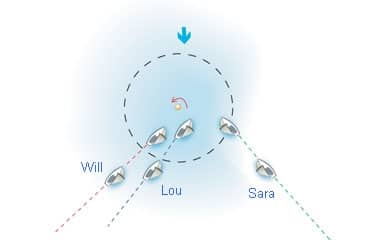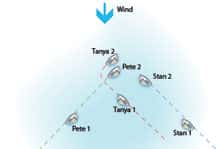
Under Rule 19.1, Lou can hail Will for room to tack and thereby keep clear of Sara.
Andy Sajor wrote to me asking how the rules apply to an incident that occurred recently in a Wednesday night PHRF race on Lake Champlain. This incident looks like one that ought to happen fairly frequently, yet I had never heard of it happening before.
By way of introducing Andy’s incident, let’s first consider how the rules apply in a simpler situation shown in the first diagram. On a windward leg, Sara is on starboard tack and Will and Lou approaching her on port. Lou cannot tack without hitting Will. Lou peeks behind his genoa and sees Sara on starboard. He realizes that he can not cross her bow. Because he can’t tack without colliding with Will and he doesn’t want to lose a couple of lengths by bearing away hard to duck behind Sara, Lou hails Will for “Room to tack”. Will responds by tacking promptly and, as soon as Lou can tack he does so. As a result Sara is able to continue on starboard unimpeded.
As I have described this situation, the applicable rules are Rules 10 and 19.1. Lou and Will were both required by Rule 10 to keep clear of Sara and they did. Because Sara had right of way over both Lou and Will, Sara was an obstruction to them. Lou was closehauled approaching the obstruction, Sara. Just before Lou hailed Will, safety required him to make a substantial course change to avoid Sara. There were two ways he could have done this: either by bearing away hard or by tacking. Each of these involved a “substantial” course change. Therefore, the conditions under which Rule 19.1 applies were satisfied and, when Lou hailed Will for room to tack, Will was required to give it. Will chose to tack (see Rule 19.1(a)) and did so as soon as possible after Lou’s hail, and Lou then tacked as soon as it was possible for him to do so. Therefore, both Will and Lou complied with Rule 19.1. No boat broke a rule and the rules smoothly permitted the boats to extricate themselves without damage or aggravation from a potentially dangerous situation. That’s how the rules are supposed to work.

Elizabeth Wishe| |**__ Pete would like to tack to keep clear of Stan, but Tanya’s tack occurs so late in the incident that there is not time for Pete to use Rule 19.1 to obtain room to tack. **|
Now let’s consider the seemingly similar situation described by Andy Sajor. It is shown in the second diagram. The boats involved were a starboard-tack C&C 33 sailed by Stan, a port-tack J/29 sailed by Pete, and a J/33 sailed by Tanya that tacked from starboard to port. The wind was about 12 knots and all three boats had genoas set.
Pete peeks behind his genoa and sees Tanya and Stan on starboard. It is obvious to Pete that Tanya will easily cross ahead of him, but he recognizes that he is on a collision course with Stan. Pete decides to tack into a safe leeward position under Stan. Just as Pete is telling his crew to prepare to tack from port to starboard, Tanya crosses his bow and, to his surprise, she immediately tacks from starboard tack into a close covering position on port tack just to windward of Pete (see position 2 in the diagram). Pete now can’t tack without colliding with Tanya, and it’s too late for him to bear off and duck behind Stan. Luckily Stan recognizes that Pete is not going to keep clear and bears off astern of him. Stan hails “Protest” intending to protest Pete for breaking Rule 10. However, as Stan finishes he fails to notify the race committee of his intent to protest as required by the sailing instructions. As a result, the protest committee finds Stan’s protest to be invalid and never addresses how the rules apply to the incident.
Andy asked me how the rules cover this situation. I will address each of the three boats in turn.
At position 2, Stan had right of way under Rule 10 over both Pete and Tanya. He was required by Rule 14 to avoid contact with Pete if it was reasonably possible to do so, and he did – by bearing away below Pete. Also, when he changed course, he was obligated to do so without breaking Rule 16.1, and he did. Stan broke no rule.
Tanya initially held right of way over Pete under Rule 10 and over Stan under Rule 12. While Tanya was changing course from a closehauled starboard-tack course to head to wind, she was obligated by Rule 16.1 to give Stan and Pete room to keep clear, which she did. From the time she turned past head to wind during her tack until she was on a closehauled port-tack course, Rule 13 required her to keep clear of both Pete and Stan, which she did. After she was on a closehauled port-tack course, she was required by Rule 11 to keep clear of Pete and by Rule 10 to keep clear of Stan, which she did. Rule 15 did not apply to Tanya after she tacked because, by tacking, she did not acquire right of way. Rule 16.1 did not apply to Tanya after she turned past head to wind because at that moment she lost right of way over both Pete and Stan, and Rule 16.1 applies only to a right of way boat. Therefore, Tanya broke no rule.
Throughout the incident Rule 10 required Pete to keep clear of Stan. He did so until shortly after position 2. However, at that time, Stan needed “to take avoiding action” in order not to collide with Pete and, therefore, at that time Pete broke Rule 10 (see the definition Keep Clear). Had there been a protest, Pete would have been disqualified.
Whoa, you say! What could Pete have done to avoid breaking Rule 10? After Tanya tacked she was preventing Pete from tacking to keep clear of Stan, and there was not enough time for Pete to hail Tanya for room to tack and for Tanya to give Pete that room. What’s more, after Tanya tacked it was too late for Pete to bear off and duck behind Stan. The timing of Tanya’s tack and the positions of the boats just after she tacked left Pete with no way to avoid breaking Rule 10. Luckily for him Stan recognized Pete’s predicament and, by bearing off, avoided what could have been a serious collision.
It sure looks like Tanya’s tack was the equivalent of a checkmate move in chess. However, there was a way for Pete to have avoided breaking Rule 10. It required quick thinking and immediate action on Pete’s part. Pete should have recognized the possibility that Tanya might tack as she did. When Tanya put her helm down to tack there was no rule that prohibited Pete from putting his own helm down at the same time and beginning to tack. Had he done so and had he turned past head to wind as, or momentarily after, Tanya turned past head to wind, then both Tanya and Pete would have been subject to Rule 13 at the same time. Tanya would have been on Pete’s port side and, therefore, under Rule 13’s second sentence, Tanya would have been required to keep clear of Pete. Tanya could then have kept clear by reversing the direction in which she was turning and resuming a closehauled starboard-tack course.
In the heat of a race, would I have thought of blocking Tanya like that? Probably not. Would you? I’ll bet you wouldn’t. Fortunately, in all my years of racing and discussing the rules I have never heard of this incident occurring. Hopefully it will never happen to you. But, if it does, now you know what to do.
Thanks to Rob Overton for sharing his analysis of Pete’s predicament with me.
E-mail for Dick Rose may be sent to rules@sailingworld.com.









